heating FORD E SERIES 2006 4.G Owners Manual
[x] Cancel search | Manufacturer: FORD, Model Year: 2006, Model line: E SERIES, Model: FORD E SERIES 2006 4.GPages: 248, PDF Size: 2.54 MB
Page 1 of 248

Introduction 4
Instrument Cluster 12
Warning and control lights 12
Gauges 16
Entertainment Systems 18
AM/FM stereo 18
AM/FM stereo with single CD 20
AM/FM stereo with in-dash six CD 24
Climate Controls 30
Heater only 30
Manual heating and air conditioning 31
Lights 33
Headlamps 33
Turn signal control 37
Bulb replacement 38
Driver Controls 43
Windshield wiper/washer control 43
Steering wheel adjustment 44
Power windows 47
Mirrors 48
Speed control 49
Locks and Security 53
Keys 53
Locks 53
Table of Contents
1
2006 Econoline(eco)
Owners Guide (post-2002-fmt)
USA(fus)
Page 16 of 248

GAUGES
Speedometer:Indicates the
current vehicle speed.
Engine coolant temperature
gauge:Indicates engine coolant
temperature. At normal operating
temperature, the needle will be in
the normal range (between “H” and
“C”).If it enters the red section,
the engine is overheating. Stop
the vehicle as soon as safely possible, switch off the engine and
let the engine cool.
Never remove the coolant reservoir cap while the engine is
running or hot.
Odometer:Registers the total miles
(kilometers) of the vehicle.
2006 Econoline(eco)
Owners Guide (post-2002-fmt)
USA(fus)
Instrument Cluster
16
Page 31 of 248

MANUAL HEATING AND AIR CONDITIONING SYSTEM
(IF EQUIPPED)
1.Fan speed adjustment:Controls
the volume of air circulated in the
vehicle.
2.Temperature selection:
Controls the temperature of the
airflow in the vehicle.
3.Air flow selections:Controls the direction of the airflow in the
vehicle. See the following for a brief description on each control.
MAX A/C:Uses recirculated air to cool the vehicle. Air flows from the
instrument panel vents only.
NORM A/C:Uses outside air to cool the vehicle. Air flows from the
instrument panel vents only.
VENT:Distributes outside air through the instrument panel vents.
OFF:Outside air is shut out and the climate system is turned off.
FLR:Distributes outside air through the floor vents.
MIX:Distributes outside air through the windshield defroster vents and
floor vents.
:Distributes outside air through the windshield defroster vents.
Operating tips
•To reduce fog build up on the windshield during humid weather, place
the air flow selector in the
position.
•To reduce humidity build up inside the vehicle: do not drive with the
air flow selector in the OFF position.
•Do not put objects under the front seats that will interfere with the
airflow to the back seats.
•Remove any snow, ice or leaves from the air intake area at the base of
the windshield.
2006 Econoline(eco)
Owners Guide (post-2002-fmt)
USA(fus)
Climate Controls
31
Page 47 of 248
![FORD E SERIES 2006 4.G Owners Manual •Drive the vehicle slowly (less than 5 km/h [3 mph]) in circles until
CAL indicator turns off in about 2–3 complete circles.
•The compass is now calibrated.
AUXILIARY POWER POINT (12VDC)
Power o FORD E SERIES 2006 4.G Owners Manual •Drive the vehicle slowly (less than 5 km/h [3 mph]) in circles until
CAL indicator turns off in about 2–3 complete circles.
•The compass is now calibrated.
AUXILIARY POWER POINT (12VDC)
Power o](/img/11/4808/w960_4808-46.png)
•Drive the vehicle slowly (less than 5 km/h [3 mph]) in circles until
CAL indicator turns off in about 2–3 complete circles.
•The compass is now calibrated.
AUXILIARY POWER POINT (12VDC)
Power outlets are designed for accessory plugs only. Do not insert
any other object in the power outlet as this will damage the
outlet and blow the fuse. Do not hang any type of accessory or
accessory bracket from the plug. Improper use of the power
outlet can cause damage not covered by your warranty.
The auxiliary power point is located
on the instrument panel.
A second power point (if equipped)
is located behind the driver’s seat on
the upper trim panel.
Do not use the power point for
operating the cigarette lighter
element (if equipped).
To prevent the fuse from being
blown, do not use the power
point(s) over the vehicle capacity of 12 VDC/180W.
To prevent the battery from being discharged, do not use the power
point longer than necessary when the engine is not running.
Always keep the power point caps closed when not being used.
Cigar/Cigarette lighter (if equipped)
Do not plug optional electrical accessories into the cigarette lighter
socket.
Do not hold the lighter in with your hand while it is heating, this will
damage the lighter element and socket. The lighter will be released from
its heating position when it is ready to be used.
Improper use of the lighter can cause damage not covered by your
warranty.
POWER WINDOWS (IF EQUIPPED)
Do not leave children unattended in the vehicle and do not let
children play with the power windows. They may seriously injure
themselves.
2006 Econoline(eco)
Owners Guide (post-2002-fmt)
USA(fus)
Driver Controls
47
Page 138 of 248
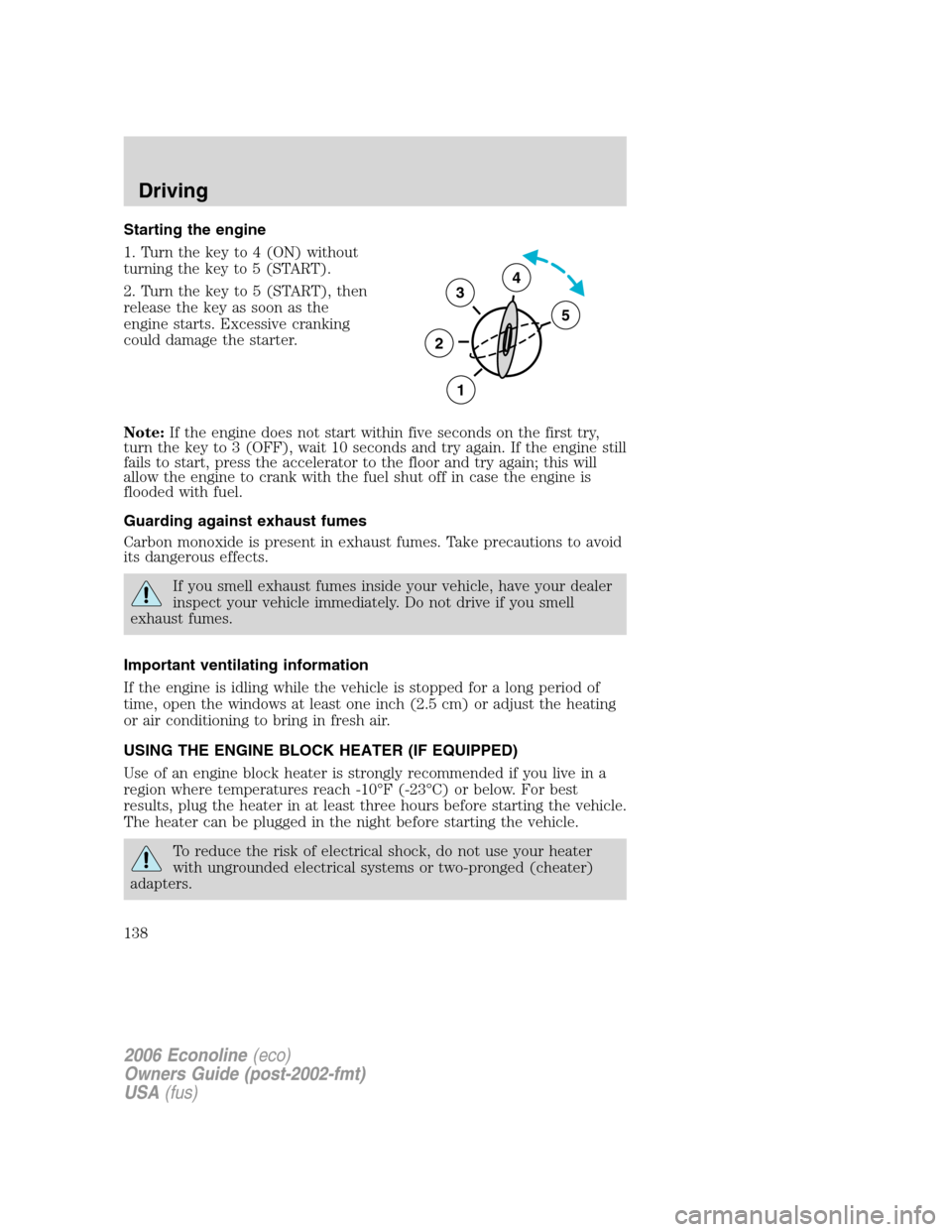
Starting the engine
1. Turn the key to 4 (ON) without
turning the key to 5 (START).
2. Turn the key to 5 (START), then
release the key as soon as the
engine starts. Excessive cranking
could damage the starter.
Note:If the engine does not start within five seconds on the first try,
turn the key to 3 (OFF), wait 10 seconds and try again. If the engine still
fails to start, press the accelerator to the floor and try again; this will
allow the engine to crank with the fuel shut off in case the engine is
flooded with fuel.
Guarding against exhaust fumes
Carbon monoxide is present in exhaust fumes. Take precautions to avoid
its dangerous effects.
If you smell exhaust fumes inside your vehicle, have your dealer
inspect your vehicle immediately. Do not drive if you smell
exhaust fumes.
Important ventilating information
If the engine is idling while the vehicle is stopped for a long period of
time, open the windows at least one inch (2.5 cm) or adjust the heating
or air conditioning to bring in fresh air.
USING THE ENGINE BLOCK HEATER (IF EQUIPPED)
Use of an engine block heater is strongly recommended if you live in a
region where temperatures reach -10°F (-23°C) or below. For best
results, plug the heater in at least three hours before starting the vehicle.
The heater can be plugged in the night before starting the vehicle.
To reduce the risk of electrical shock, do not use your heater
with ungrounded electrical systems or two-pronged (cheater)
adapters.
3
2
1
5
4
2006 Econoline(eco)
Owners Guide (post-2002-fmt)
USA(fus)
Driving
138
Page 208 of 248
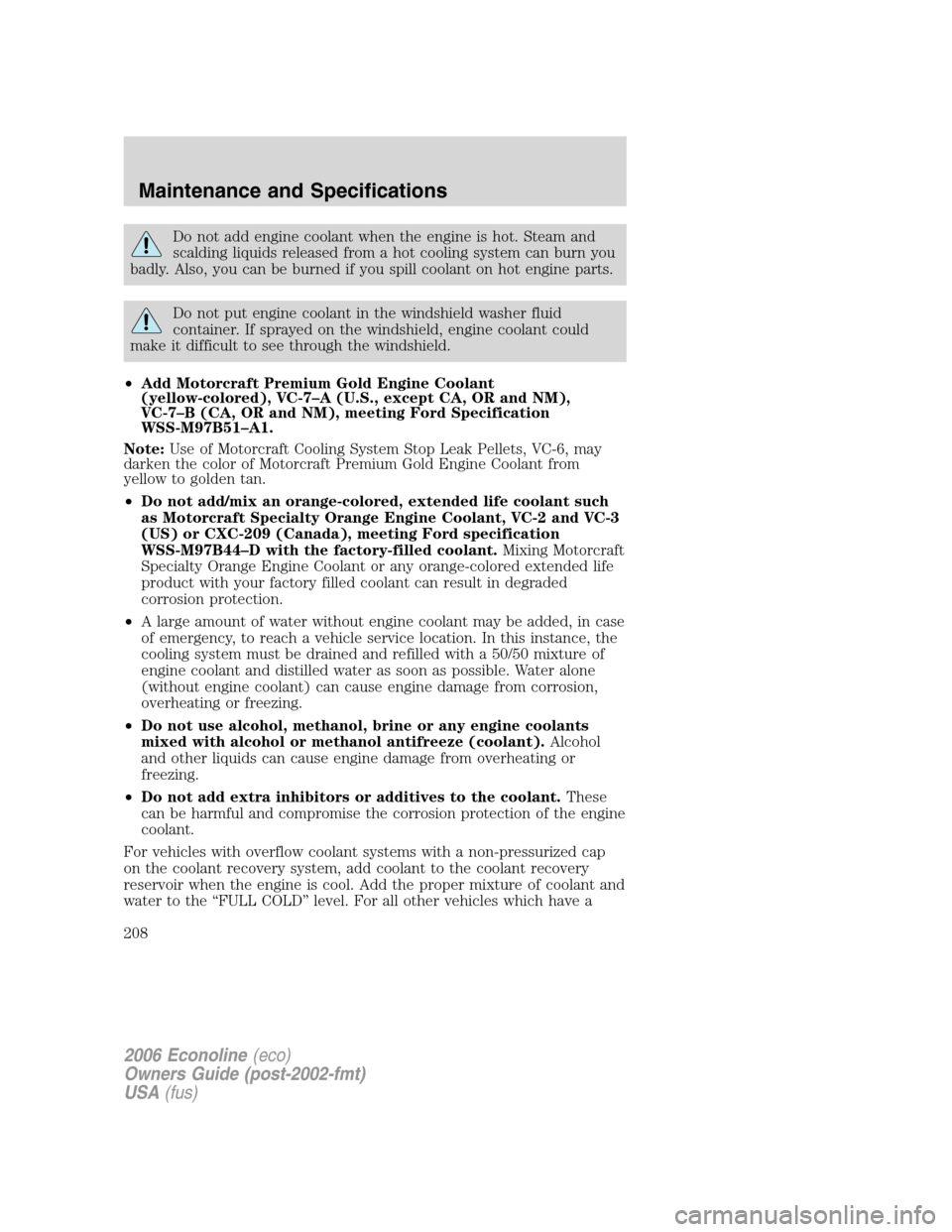
Do not add engine coolant when the engine is hot. Steam and
scalding liquids released from a hot cooling system can burn you
badly. Also, you can be burned if you spill coolant on hot engine parts.
Do not put engine coolant in the windshield washer fluid
container. If sprayed on the windshield, engine coolant could
make it difficult to see through the windshield.
•Add Motorcraft Premium Gold Engine Coolant
(yellow-colored), VC-7–A (U.S., except CA, OR and NM),
VC-7–B (CA, OR and NM), meeting Ford Specification
WSS-M97B51–A1.
Note:Use of Motorcraft Cooling System Stop Leak Pellets, VC-6, may
darken the color of Motorcraft Premium Gold Engine Coolant from
yellow to golden tan.
•Do not add/mix an orange-colored, extended life coolant such
as Motorcraft Specialty Orange Engine Coolant, VC-2 and VC-3
(US) or CXC-209 (Canada), meeting Ford specification
WSS-M97B44–D with the factory-filled coolant.Mixing Motorcraft
Specialty Orange Engine Coolant or any orange-colored extended life
product with your factory filled coolant can result in degraded
corrosion protection.
•A large amount of water without engine coolant may be added, in case
of emergency, to reach a vehicle service location. In this instance, the
cooling system must be drained and refilled with a 50/50 mixture of
engine coolant and distilled water as soon as possible. Water alone
(without engine coolant) can cause engine damage from corrosion,
overheating or freezing.
•Do not use alcohol, methanol, brine or any engine coolants
mixed with alcohol or methanol antifreeze (coolant).Alcohol
and other liquids can cause engine damage from overheating or
freezing.
•Do not add extra inhibitors or additives to the coolant.These
can be harmful and compromise the corrosion protection of the engine
coolant.
For vehicles with overflow coolant systems with a non-pressurized cap
on the coolant recovery system, add coolant to the coolant recovery
reservoir when the engine is cool. Add the proper mixture of coolant and
water to the “FULL COLD” level. For all other vehicles which have a
2006 Econoline(eco)
Owners Guide (post-2002-fmt)
USA(fus)
Maintenance and Specifications
208
Page 209 of 248
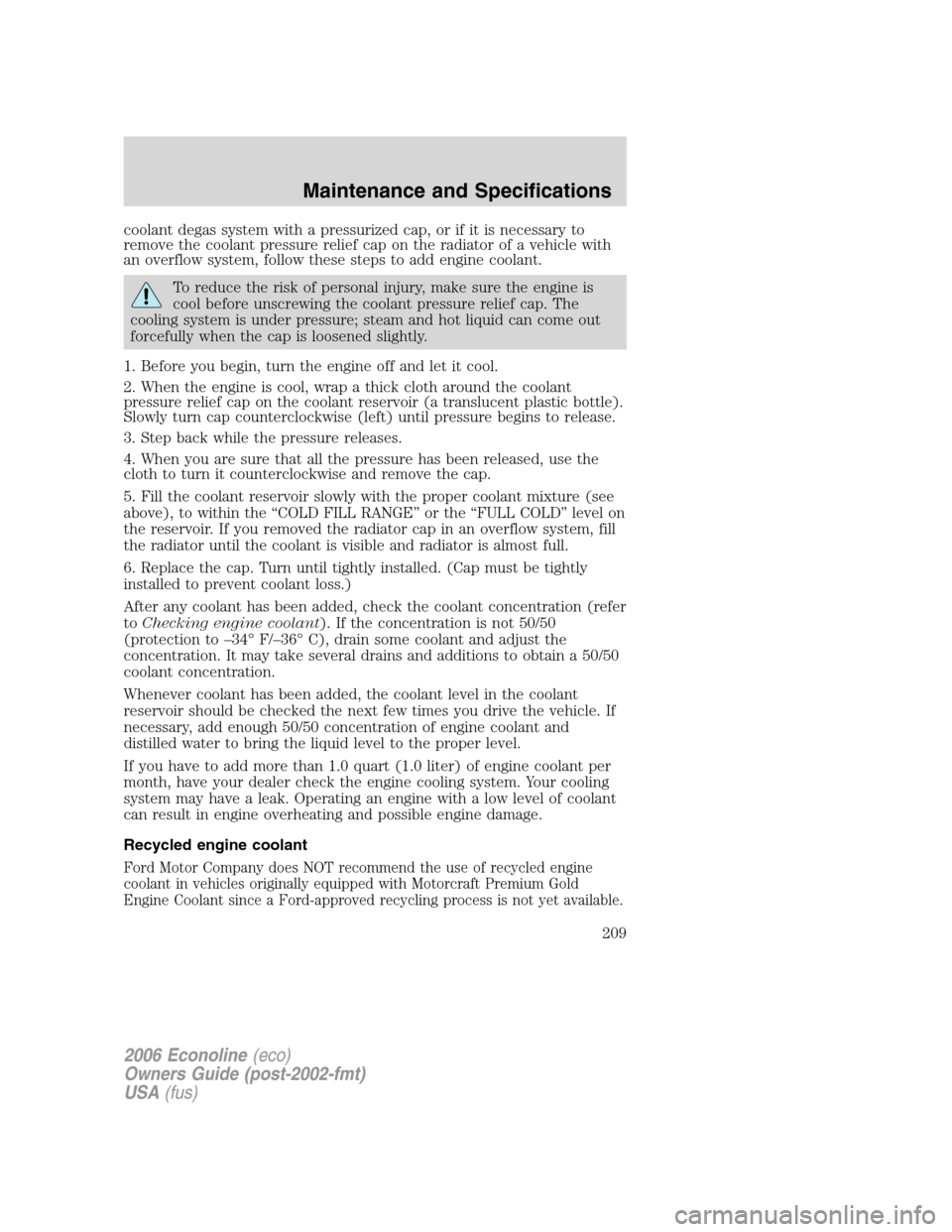
coolant degas system with a pressurized cap, or if it is necessary to
remove the coolant pressure relief cap on the radiator of a vehicle with
an overflow system, follow these steps to add engine coolant.
To reduce the risk of personal injury, make sure the engine is
cool before unscrewing the coolant pressure relief cap. The
cooling system is under pressure; steam and hot liquid can come out
forcefully when the cap is loosened slightly.
1. Before you begin, turn the engine off and let it cool.
2. When the engine is cool, wrap a thick cloth around the coolant
pressure relief cap on the coolant reservoir (a translucent plastic bottle).
Slowly turn cap counterclockwise (left) until pressure begins to release.
3. Step back while the pressure releases.
4. When you are sure that all the pressure has been released, use the
cloth to turn it counterclockwise and remove the cap.
5. Fill the coolant reservoir slowly with the proper coolant mixture (see
above), to within the “COLD FILL RANGE” or the “FULL COLD” level on
the reservoir. If you removed the radiator cap in an overflow system, fill
the radiator until the coolant is visible and radiator is almost full.
6. Replace the cap. Turn until tightly installed. (Cap must be tightly
installed to prevent coolant loss.)
After any coolant has been added, check the coolant concentration (refer
toChecking engine coolant). If the concentration is not 50/50
(protection to –34° F/–36° C), drain some coolant and adjust the
concentration. It may take several drains and additions to obtain a 50/50
coolant concentration.
Whenever coolant has been added, the coolant level in the coolant
reservoir should be checked the next few times you drive the vehicle. If
necessary, add enough 50/50 concentration of engine coolant and
distilled water to bring the liquid level to the proper level.
If you have to add more than 1.0 quart (1.0 liter) of engine coolant per
month, have your dealer check the engine cooling system. Your cooling
system may have a leak. Operating an engine with a low level of coolant
can result in engine overheating and possible engine damage.
Recycled engine coolant
Ford Motor Company does NOT recommend the use of recycled engine
coolant in vehicles originally equipped with Motorcraft Premium Gold
Engine Coolant since a Ford-approved recycling process is not yet available.
2006 Econoline(eco)
Owners Guide (post-2002-fmt)
USA(fus)
Maintenance and Specifications
209
Page 225 of 248
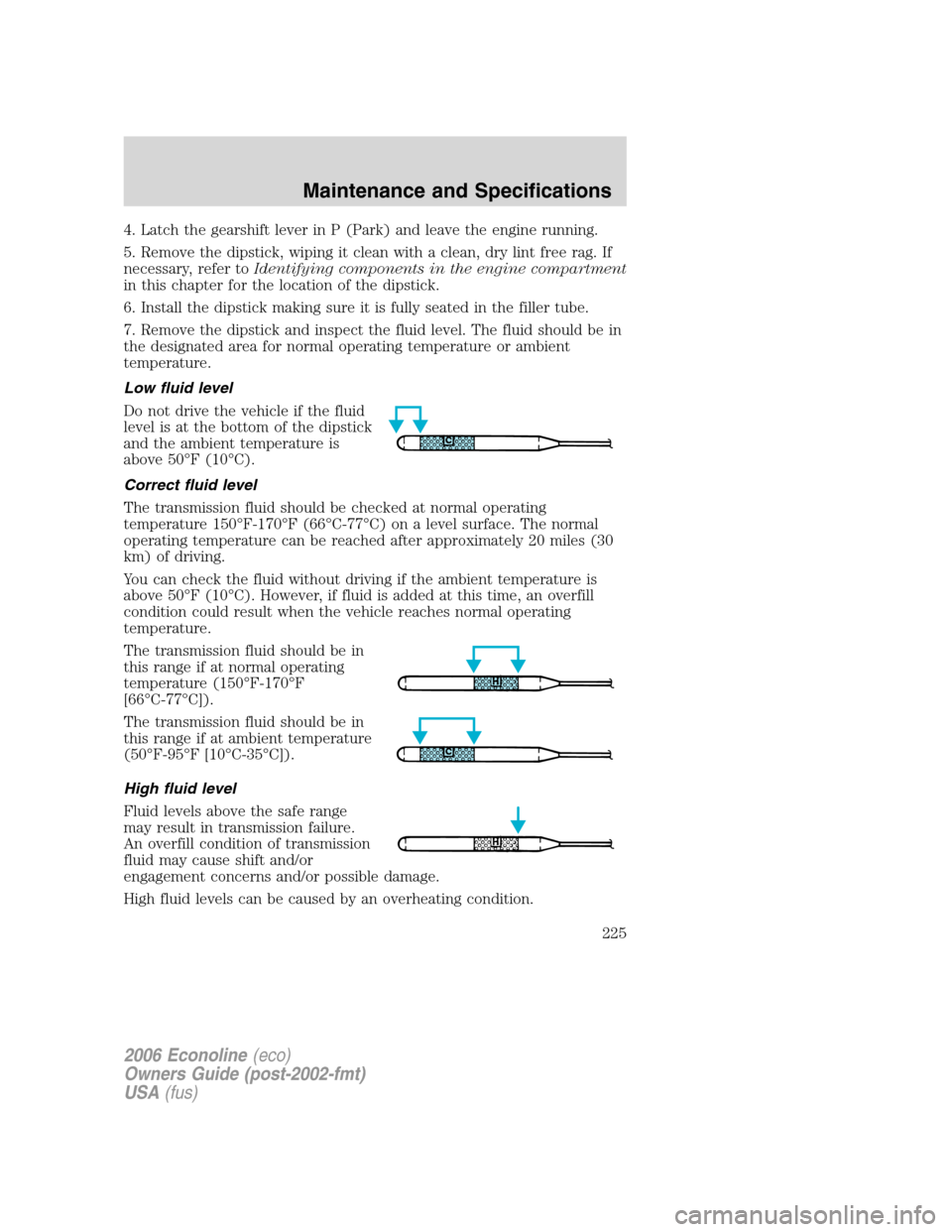
4. Latch the gearshift lever in P (Park) and leave the engine running.
5. Remove the dipstick, wiping it clean with a clean, dry lint free rag. If
necessary, refer toIdentifying components in the engine compartment
in this chapter for the location of the dipstick.
6. Install the dipstick making sure it is fully seated in the filler tube.
7. Remove the dipstick and inspect the fluid level. The fluid should be in
the designated area for normal operating temperature or ambient
temperature.
Low fluid level
Do not drive the vehicle if the fluid
level is at the bottom of the dipstick
and the ambient temperature is
above 50°F (10°C).
Correct fluid level
The transmission fluid should be checked at normal operating
temperature 150°F-170°F (66°C-77°C) on a level surface. The normal
operating temperature can be reached after approximately 20 miles (30
km) of driving.
You can check the fluid without driving if the ambient temperature is
above 50°F (10°C). However, if fluid is added at this time, an overfill
condition could result when the vehicle reaches normal operating
temperature.
The transmission fluid should be in
this range if at normal operating
temperature (150°F-170°F
[66°C-77°C]).
The transmission fluid should be in
this range if at ambient temperature
(50°F-95°F [10°C-35°C]).
High fluid level
Fluid levels above the safe range
may result in transmission failure.
An overfill condition of transmission
fluid may cause shift and/or
engagement concerns and/or possible damage.
High fluid levels can be caused by an overheating condition.
2006 Econoline(eco)
Owners Guide (post-2002-fmt)
USA(fus)
Maintenance and Specifications
225
Page 244 of 248
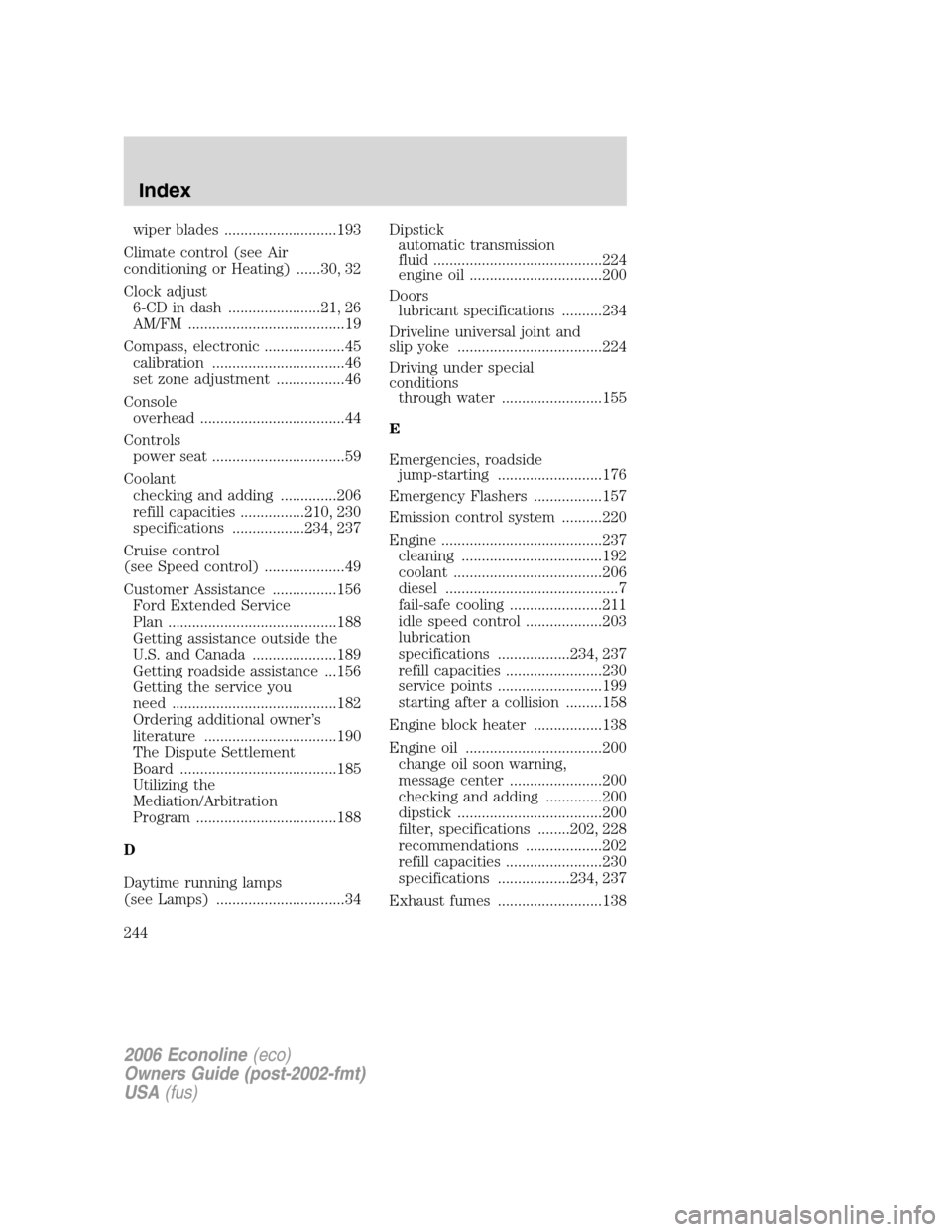
wiper blades ............................193
Climate control (see Air
conditioning or Heating) ......30, 32
Clock adjust
6-CD in dash .......................21, 26
AM/FM .......................................19
Compass, electronic ....................45
calibration .................................46
set zone adjustment .................46
Console
overhead ....................................44
Controls
power seat .................................59
Coolant
checking and adding ..............206
refill capacities ................210, 230
specifications ..................234, 237
Cruise control
(see Speed control) ....................49
Customer Assistance ................156
Ford Extended Service
Plan ..........................................188
Getting assistance outside the
U.S. and Canada .....................189
Getting roadside assistance ...156
Getting the service you
need .........................................182
Ordering additional owner’s
literature .................................190
The Dispute Settlement
Board .......................................185
Utilizing the
Mediation/Arbitration
Program ...................................188
D
Daytime running lamps
(see Lamps) ................................34Dipstick
automatic transmission
fluid ..........................................224
engine oil .................................200
Doors
lubricant specifications ..........234
Driveline universal joint and
slip yoke ....................................224
Driving under special
conditions
through water .........................155
E
Emergencies, roadside
jump-starting ..........................176
Emergency Flashers .................157
Emission control system ..........220
Engine ........................................237
cleaning ...................................192
coolant .....................................206
diesel ...........................................7
fail-safe cooling .......................211
idle speed control ...................203
lubrication
specifications ..................234, 237
refill capacities ........................230
service points ..........................199
starting after a collision .........158
Engine block heater .................138
Engine oil ..................................200
change oil soon warning,
message center .......................200
checking and adding ..............200
dipstick ....................................200
filter, specifications ........202, 228
recommendations ...................202
refill capacities ........................230
specifications ..................234, 237
Exhaust fumes ..........................138
2006 Econoline(eco)
Owners Guide (post-2002-fmt)
USA(fus)
Index
244
Page 245 of 248
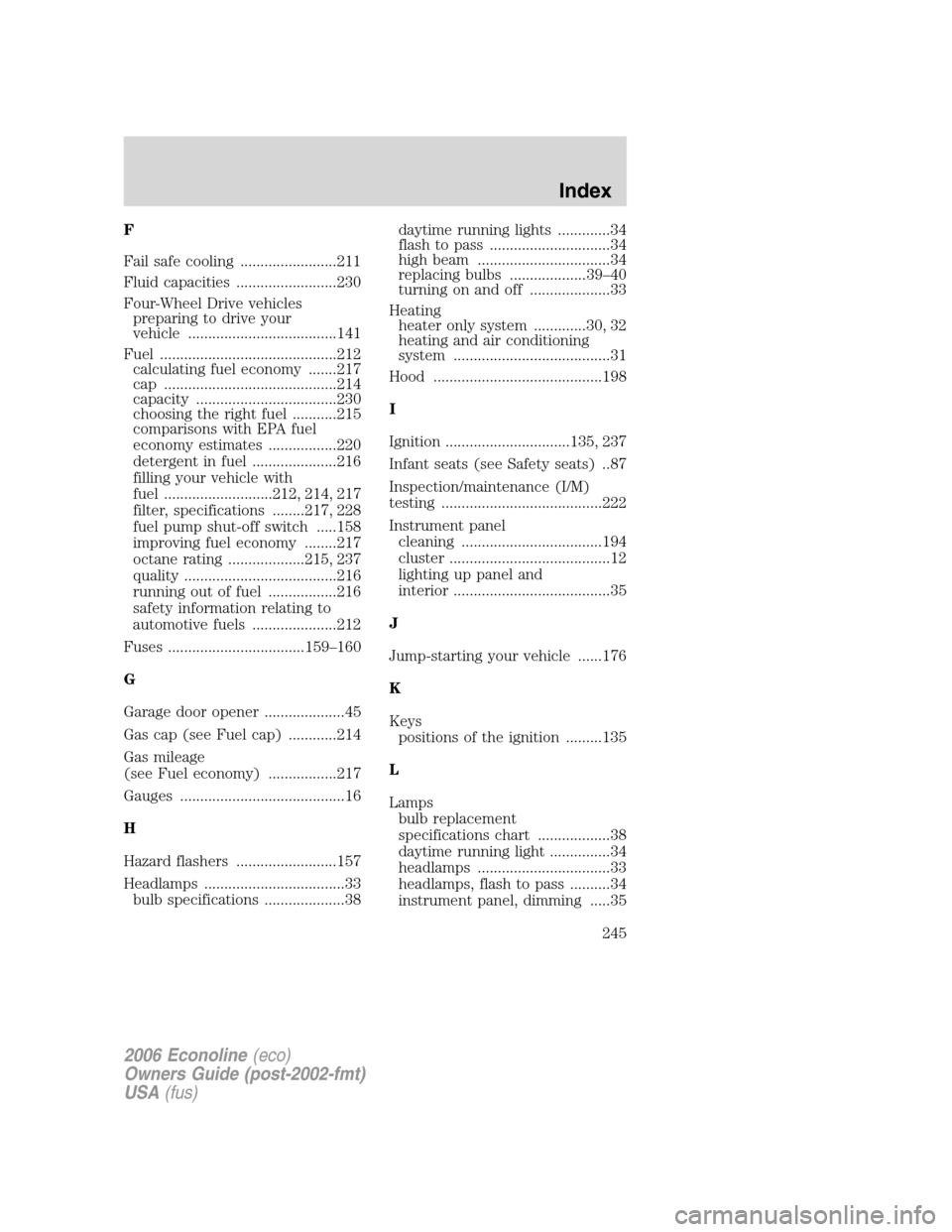
F
Fail safe cooling ........................211
Fluid capacities .........................230
Four-Wheel Drive vehicles
preparing to drive your
vehicle .....................................141
Fuel ............................................212
calculating fuel economy .......217
cap ...........................................214
capacity ...................................230
choosing the right fuel ...........215
comparisons with EPA fuel
economy estimates .................220
detergent in fuel .....................216
filling your vehicle with
fuel ...........................212, 214, 217
filter, specifications ........217, 228
fuel pump shut-off switch .....158
improving fuel economy ........217
octane rating ...................215, 237
quality ......................................216
running out of fuel .................216
safety information relating to
automotive fuels .....................212
Fuses ..................................159–160
G
Garage door opener ....................45
Gas cap (see Fuel cap) ............214
Gas mileage
(see Fuel economy) .................217
Gauges .........................................16
H
Hazard flashers .........................157
Headlamps ...................................33
bulb specifications ....................38daytime running lights .............34
flash to pass ..............................34
high beam .................................34
replacing bulbs ...................39–40
turning on and off ....................33
Heating
heater only system .............30, 32
heating and air conditioning
system .......................................31
Hood ..........................................198
I
Ignition ...............................135, 237
Infant seats (see Safety seats) ..87
Inspection/maintenance (I/M)
testing ........................................222
Instrument panel
cleaning ...................................194
cluster ........................................12
lighting up panel and
interior .......................................35
J
Jump-starting your vehicle ......176
K
Keys
positions of the ignition .........135
L
Lamps
bulb replacement
specifications chart ..................38
daytime running light ...............34
headlamps .................................33
headlamps, flash to pass ..........34
instrument panel, dimming .....35
2006 Econoline(eco)
Owners Guide (post-2002-fmt)
USA(fus)
Index
245